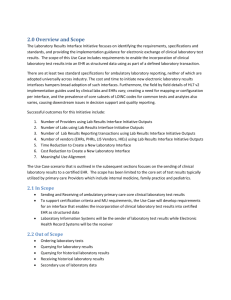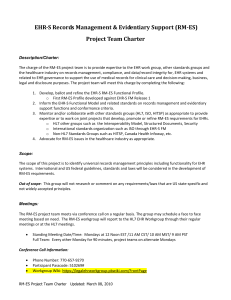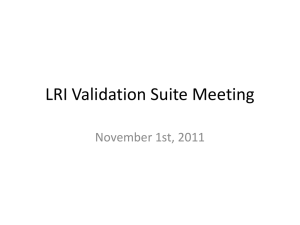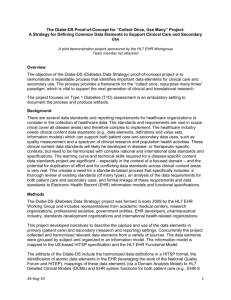2.0 Overview and Scope
advertisement
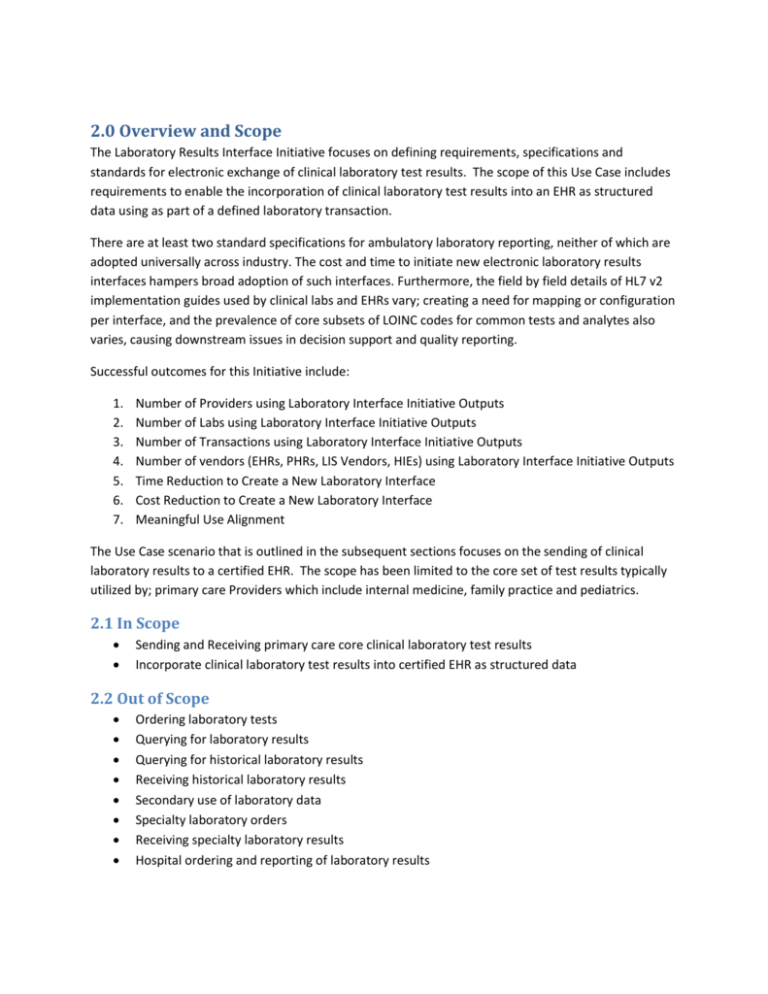
2.0 Overview and Scope The Laboratory Results Interface Initiative focuses on defining requirements, specifications and standards for electronic exchange of clinical laboratory test results. The scope of this Use Case includes requirements to enable the incorporation of clinical laboratory test results into an EHR as structured data using as part of a defined laboratory transaction. There are at least two standard specifications for ambulatory laboratory reporting, neither of which are adopted universally across industry. The cost and time to initiate new electronic laboratory results interfaces hampers broad adoption of such interfaces. Furthermore, the field by field details of HL7 v2 implementation guides used by clinical labs and EHRs vary; creating a need for mapping or configuration per interface, and the prevalence of core subsets of LOINC codes for common tests and analytes also varies, causing downstream issues in decision support and quality reporting. Successful outcomes for this Initiative include: 1. 2. 3. 4. 5. 6. 7. Number of Providers using Laboratory Interface Initiative Outputs Number of Labs using Laboratory Interface Initiative Outputs Number of Transactions using Laboratory Interface Initiative Outputs Number of vendors (EHRs, PHRs, LIS Vendors, HIEs) using Laboratory Interface Initiative Outputs Time Reduction to Create a New Laboratory Interface Cost Reduction to Create a New Laboratory Interface Meaningful Use Alignment The Use Case scenario that is outlined in the subsequent sections focuses on the sending of clinical laboratory results to a certified EHR. The scope has been limited to the core set of test results typically utilized by; primary care Providers which include internal medicine, family practice and pediatrics. 2.1 In Scope Sending and Receiving primary care core clinical laboratory test results Incorporate clinical laboratory test results into certified EHR as structured data 2.2 Out of Scope Ordering laboratory tests Querying for laboratory results Querying for historical laboratory results Receiving historical laboratory results Secondary use of laboratory data Specialty laboratory orders Receiving specialty laboratory results Hospital ordering and reporting of laboratory results 2.3 Background The Laboratory Results Interface Initiative and the subsequent Laboratory Results Reporting to Primary Care Providers (in an Ambulatory Setting) Use Case has been selected because of its alignment with Meaningful Use Stage 1 and foreseen Stage 2 indications as well as addressing various Prioritization Criteria as described below. The Laboratory Results Interface Initiative holds importance and relevance in that it: It enables stage 1 and potential stage 2 Meaningful Use criteria o Stage 1: Incorporation of laboratory results as structured data o Stage 2: Automating the laboratory results interface The Initiative requires and supports information interchange. Messaging and vocabulary standards exist but due to the high degree of allowable variation implementation of laboratory interfaces is time consuming and costly. This Initiative will leverage existing interoperability standards and specifications when defining the Use Case and functional requirements. There are two previous efforts, neither of which was widely adopted, that resulted in implementation guides and specifications for laboratory results. The Healthcare and Interoperability Standards Panel HITSP/IS01. The Electronic Health Records Laboratory Results Reporting Interoperability Specification and HITSP/C36 Laboratory Message Component in combination define and constrain the use of the HL7 Version 2.5.1. Implementation Guide: Order and Observations; Interoperable Laboratory Results Reporting to Electronic Health Record (EHR), Release 1. EHR-Laboratory Interoperability and Connectivity Specification (ELINCS) also constrained the HL7 Version 2.5.1 Implementation Guide which resulted in the HL7 2.5.1 Implementation Guide: Orders and Observations; Ambulatory Laboratory Results (ELINCS), Release 1. 2.4 Policy Issues The Use Cases strive to address relevant and timely policy issues that will have downstream effects on the US healthcare reform agenda; specifically relevant to healthcare information technology. Without a widely accepted standard for laboratory results exchange several issues will arise in relation to clinical decision support and quality reporting. Meaningful Use Criteria: Incorporate Laboratory results as structured data into Electronic Health Record Certification Criteria: Receive results in structured format and display in human readable format. The Medicare and Medicaid EHR Incentive Programs do not specify the use of code set standards in meeting the measure for this objective. However, the Office of the National Coordinator for Health Information Technology (ONC) has adopted Logical Observation Identifiers Names and Codes (LOINC®) version 2.27, when such codes were received within an electronic transaction from a laboratory, for the entry of structured data for this measure and made this a requirement for EHR technology to be certified. 2.5 Regulatory Issues The Centers for Medicare & Medicaid Services (CMS) regulates all laboratory testing (except research) performed on humans in the U.S. through the Clinical Laboratory Improvement Amendments (CLIA). In total, CLIA covers approximately 200,000 laboratory entities. The Division of Laboratory Services, within the Survey and Certification Group, under the Center for Medicaid and State Operations (CMSO) has the responsibility for implementing the CLIA Program. The objective of the CLIA program is to ensure quality laboratory testing. Although all clinical laboratories must be properly certified to receive Medicare or Medicaid payments, CLIA has no direct Medicare or Medicaid program responsibilities. Interpretations of legal requirements across the states and laboratory sources vary widely and there is currently no ability to monitor/enforce standards. 2.6 Communities of Interest Communities of Interest are public and private stakeholders that are directly involved in the business process or are involved in the development and use of interoperable implementation guides and implementation of the Solution. Some members are business actors. Communities of Interest may directly participate in the exchange, that is they are actors, or indirectly through the results of the improved business process. The following list of Communities of Interest and their definitions are for discussion purposes for clinical information exchange: Member of Communities of Interests Patient Consumers Care Coordinators Clinicians Provider Laboratories Working Definition Members of the public Members of the public who require healthcare services from ambulatory, emergency department, physician’s Office, and/or the Public Health Agency/Department. Members of the public that include patients as well as caregivers, patient advocates, surrogates, family members, and other parties who may be acting for, or in support of, a patient receiving or potentially receiving healthcare services. Individuals who support clinicians in the management of health and disease conditions. These can include case managers and others. Healthcare Providers with patient care responsibilities, including physicians, advanced practice nurses, physician assistants, nurses, psychologists, pharmacists, and other licensed and credentialed personnel involved in treating patients.. An individual clinician or care delivery setting who requests or accepts the transfer of the clinical summary for the purposes of delivering care. A laboratory (often abbreviated lab) is a setting where specimens are sent for testing and analysis are resulted, and then results are communicated back to the requestor. The Laboratory Information System(LIS) Provider Organizations Standards Organizations Electronic Health Record/Personal Health Record Vendors Federal Agencies types of laboratories may include clinical/medical, environmental, and veterinarian, and may be both private and/or public. Laboratory Information System is an information system that receives, processes, and stores information generated by a medical laboratory processes. LIS is often interfaced with HIS and EMR applications. Organizations that are engaged in or support the delivery of healthcare to include Hospitals Ambulatory Centers and Provider Practices. Organizations whose purpose is to define, harmonize and integrate standards that will meet clinical and business needs for sharing information among organizations and systems. Vendors which provide specific EHR/PHR solutions to clinicians such as software applications and software services. These suppliers may include developers, Providers, resellers, operators, and others who may provide these or similar capabilities. TBD by UCR Workgroup Participants
